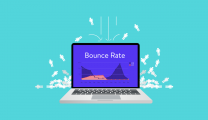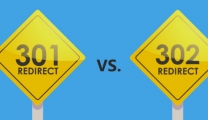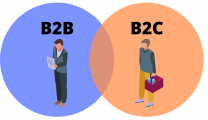What is B2B Market Research?
B2B market research refers to the process used to obtain data and insights within your industry.
This data then helps you identify what your target audience needs and wants. B2B market research can be anything from brand perception to sales and marketing strategies.
B2B market research consists of taking a sample of the target audience and learning their preferences and motivations.
This helps you understand how your audience feels, thinks, and acts, which can help in the creation of a more strategic plan for the future.
How Does Market Research Differ Between B2B and B2C?
B2B is a big concept, but it is vastly different from B2C. The markets themselves are different, and as a result, the market research cannot be the same.
So, how exactly are the two markets different?
The “who” of being sold to is different
With B2B, the focus is a business selling to a business, whereas the focus is a business selling to a consumer with B2C.
B2B tends to require more convincing to make a purchase than B2C markets, as a result, the market research must be far more detailed and in-depth.
Further, better incentives may need to be offered to B2B markets to encourage them to choose your company to do business with.
The types of products being sold (and where) are not the same
Spending tends to be higher in B2B markets as opposed to B2C markets.
The products being sold also tend to be more complex and customized.
B2C tends to be simpler overall. Further, the products are more likely to be sold via multiple channels of distribution.
Purchases are made differently in B2B markets than in B2C markets
When compared to the B2C buying journey, the B2B purchasing journey is much longer, has more stages, and has more stakeholders.
More information tends to be required throughout the buying journey as well, and these purchases aren’t as focused on emotional touchpoints as B2C is.
.jpeg)
Why is B2B Market Research Critical?
Now let’s learn some of the benefits of B2B market research.
Help to Understand and Build B2B Buyer Personas
Market research gives you a closer look at who your potential customers are.
With this information, you can better understand what your customers need from you, allowing you to create more accurate B2B buyer personas to help fuel your efforts.
Evaluate the Changing Needs of Customers
It isn’t uncommon for the needs of customers to change every now and then, and it can be difficult to keep up with these changing customer needs.
Through B2B market research, you can stay abreast of new developments in customer behavior and use this data to help solidify your future plans.
Differentiate Themselves from Competitors
Gaining a competitive advantage in some industries can be difficult, and without the proper research into the market, it is virtually impossible to set yourself apart from your competitors.
Luckily, B2B market research helps to identify where you stand and how you can separate yourself from the crowd.
Refine Their Offerings
Brands often assume they know what is best to take to market and promote to their customers. However, with market research, you simply cannot be 100 percent sure you are moving in the right direction.
Market research allows you to refine the products and services you’re offering to ensure they match up well with customer needs.
What are the Types of B2B Marketing Research?
There are numerous types of market research that can be performed.
B2B market research tends to consist of four main methods: primary, secondary, qualitative, and quantitative. Each one has its own set of pros and cons, so it is important to familiarize yourself with all of them before determining how to move forward.
#1. Primary Research
Primary research consists of speaking directly to your target audience in order to gain valuable data and insights.
It has the potential to make an emotional connection with your audience and can get data directly from participants.
Unfortunately, this can be a very time-consuming and costly method of obtaining market research, as you are gathering significant amounts of data that must be analyzed thoroughly.
Further, it is important that the experience is as quick, easy, and painless as possible, since B2B participants may have less interest in helping with your research.
#2. Secondary Research
Secondary research is conducted by a third party and tends to be available to the public, such as financial reports and analyst reports.
This particular research method is important since it can help bring in data from outside.
For instance, primary research like asking people for their answers directly may not uncover their true intentions. Secondary research can often help in the understanding of audience behavior.
Before investing in secondary research, you must make sure that the data you acquire from a third-party source will be beneficial for your needs.
Further, secondary research data can often be inaccurate or biased, which means you must confirm the authenticity of your sources.
#3. Qualitative Research
Qualitative research consists of data collection that simply cannot be defined by numbers.
This type of data can be beneficial in understanding possible reasons why your audience reacts the way they do. You can build a hypothesis regarding your target audience and prospective customers with qualitative research.
Qualitative research can be obtained through interviews, focus groups, and open-ended survey questions.
It can be particularly useful when your audience isn’t considerably large, making it more difficult to gain quantitative data.
Additionally, this approach tends to be more personalized, which is a huge turn-on for B2B decision-makers. It allows the development of a much more personal and closer relationship with prospects.
Keep in mind that this particular type of research method can be time-consuming. It can also be difficult to properly analyze data to compare.
There is also a chance that the interviewer may skew the results, potentially leading to biased results. For focus groups, there may be scheduling conflicts.
#4. Quantitative Research
Quantitative research collects data that can be defined by numbers.
It tends to be more definitive than qualitative data and can be used to prove a hypothesis. This type of research can be obtained through surveys, questionnaires, and pools.
The great thing about quantitative data is that it is easy to use numbers for comparison.
It also tends to be more cost-effective to gather a significant number of participant responses.
Bias is considerably reduced due to the fact that there is no personal element in the research. It is also easy for this type of research to fit into the busy schedule of decision-makers.
The main problem with quantitative research is that your audience may not be as inclined to provide their feedback or their answers may be basic and vague due to the fact that these surveys tend to be less personal in nature.
How to Conduct B2B Market Research
Now that you’re a little bit more familiar with B2B market research, you may be curious as to how to perform this type of research. Here are a few tips to get you started.

1. Identify the Research Topic
If you need specific answers to questions, then you will want to conduct exploratory research. This research is generic and broad.
Open-ended interviews are often used, and qualitative data tend to be more beneficial with this route.
If you know the specific parameters of your topic, such as how successful a certain product is or if there is a problem to solve, then specific research should be your go-to.
Overall, the approach you take will be much more structured, and quantitative data proves to be the most beneficial.
2. Select Participants
You must also choose your participants — individuals from your target audience.
They will help you make strategic decisions that are well-informed. Make sure your sample size is of a decent size and you have a solid mix of participants so your results are optimal for your needs.
You can ask current or interested customers, create your own research panel, purchase a list, advertise on your website or within a specific industry community, and more.
3. Engage Participants
Once you have identified the approach you are taking and chosen your participants, you must figure out how you will entertain participants and get their attention.
Ideally, the best way to do this is to get personal with each and every participant and offer several different methods of response.
For the best results, avoid peak times of the day and year for the industry to conduct your market research.
Don’t forget to give participants a reason to take part in your market research, such as tailored products, potential improvements, or financial incentives.












Replies to This Discussion